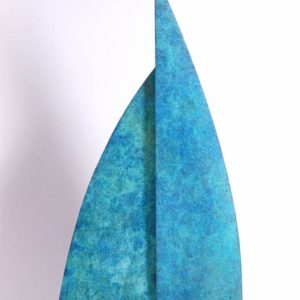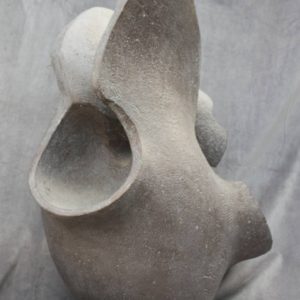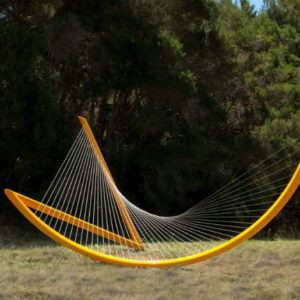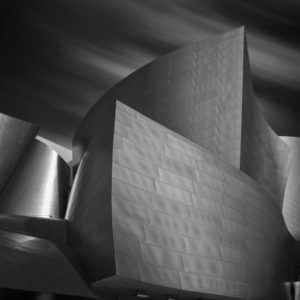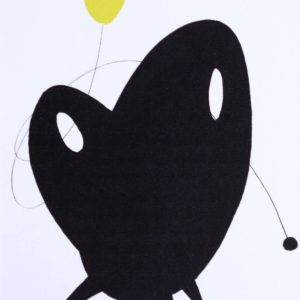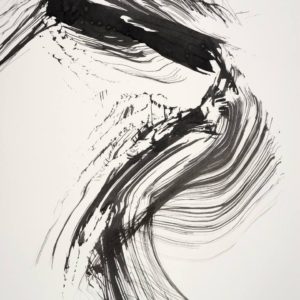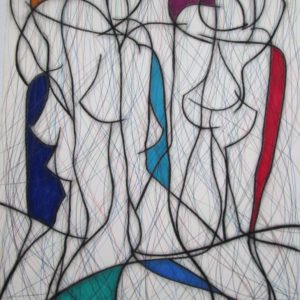Art History 101
Frank Gehry: Artist and Architect
“Mr. Gehry is an architect of immense gifts who dances on the line separating architecture from art but who manages never to let himself fall.” – Paul Goldberger
As today marks the 88th birthday of Frank Gehry, we celebrate the unique life and ingenuity of this iconic architect and artist. In an era where stark modernist buildings littered city landscapes, Frank Gehry brought Deconstructivism, a movement that replaced geometric order with lively, fluid structures. While most of us are well-versed in his famous buildings, like the Walt Disney Concert Hall in Los Angeles or the Guggenheim Museum in Bilbao, Spain, many of us are unfamiliar with his personal art practice.
Read on to learn more about a master architect’s diverse artistic practice.
Built to Human Form
If we begin with the two most iconic Gehry designs, a basic understanding of the philosophy and history of their structures brings a further understanding to his artistic practice. The Guggenheim Bilbao was built in 1997, and upon its opening was hailed as the most important building of its time. The plan to redesign the museum began in the 1980’s, and Gehry chose to use contemporary cutting-edge computers as an aide. His development of the 35,000 sqm site along the Nervión River and midst the urban city was heralded as a flawless integration of the modern with the historic. This integration is a key feature in Gehry’s work that influenced his design for the Walt Disney Concert Hall. For this building, Gehry was inspired by his love for sailing and creating a building that represented the complexity and feel of Los Angeles. It was a miracle that the project was ever finished — after two stalls due to lack of funding and issues over construction, the project was finally underway in 1997 after a gift from Disney’s daughter, Diane Disney Miller, that ensured Gehry’s full control of the building process. Gehry’s complete jurisdiction resulted in a flowering, masterful form that is neatly contained within a city block and home to a world-class acoustic system. Like with the Guggenheim, the Disney Concert Hall stands as a unique structure unto its own, all the while being effortlessly “Gehry” and integrating itself into the city landscape.
“The fish is a perfect form.”
While he is most well-known for his whimsical buildings, as an inherently creative person, Gehry also developed an art practice throughout his lifetime. Between the years of 1984 and 1986, Gehry was working with plastic laminate ColorCore for a commission for Formica. After accidentally shattering one of the pieces of ColorCore, Gehry decided to use the small pieces as fish scales and glue them onto a wire skeleton. For the finished product, he placed a light in the belly of the fish and placed them swimming up and down walls, or on tables. They were first shown in an 1984 exhibition at Gagosian Gallery, “Frank Gehry: Unique Lamps,” and later revisited in 2013 for another exhibition at Gagosian and LACMA. The fish lamps are perhaps so convincing because Gehry uses an entirely unexpected material to successfully mimic the liveliness and lightness of the fish body. Like his work at the Walt Disney Concert Hall, Gehry uses small pieces of hard material to create curves and an organic feeling that breathes life. Check out images of the Gehry’s fish sculptures at Gagosian Gallery.
Printmaker and Artist
Gehry’s relationship with the internationally heralded printmaking studio, Gemini G.E.L. (Graphic Editions Limited), dates back to the 60’s, two decades after Gehry first moved to sunny Los Angeles from Toronto. His strong friendship with several of the Gemini artists, including Ed Ruscha, and the owners, Stanley and Elyse Grinstein and Sidney Felsen, led him to design an additional building for the studio in 1977. Gehry embarked on his first artistic collaboration with the studio in 1998 with a fiberglass sculpture in a shape he had developed for the DG Bank building in Berlin. Since then, he has worked with the studio every several years, producing colored fiberglass work and lithograph prints. In 2007, he began printing in earnest, producing five series of lithographs published over a period of several years, followed by another sculpture edition in 2012, and most recently a suite of etchings.
In his lithographic works, such as “Puzzled #1 (State B)” (2013) or “Marques de Riscal Winery” (2009), Gehry’s fluid form and the liveliness of touch is demonstrated on paper. Moreover, these lithographs show how sketching by hand is an integral part of Gehry’s creative process. A recent exhibition at LACMA featured over 200 drawings and 3-D models, highlighting the artistic and expressive process by which Gehry conceptualizes and creates.
Breakfast at Gehry’s
Few are aware that Gehry’s artistic process is not simply limited to the pen, paper, or sculpture. In 2006, Gehry launched a jewelry line with Tiffany and Co., extending his talents to wearable artistic creation. The collection was to exude vitality, “skillfully realizing the spontaneous twists and turns of the architect’s inventive style.” (Tiffany & Co. Press Release)
Additionally, in 2004 Gehry was asked to re-design the National Hockey League’s World Cup. As a native Canadian, hockey remained close to Gehry’s heart in his youth, and he took on the challenge, admitting he didn’t necessarily know what he was getting himself into. They unveiled the 2004 trophy to some mixed reviews, though Gehry himself sought to mimic the lines of skates across the ice in the trophy. In 2016, Gehry even gave the trophy a facelift, making the exterior glass more transparent, but the same essential design persisted. At 32 pounds and 26.5 inches tall, the names of the 1996 and 2004 world champions are laser etched into the trophy’s surface, making it a triumphant, though controversial, artistic feat.
Today, as we celebrate the life of such an iconic architect, we remember his contribution to the greater arts and follow in suit, daring to be creative, break molds, and dream fearlessly.
Love reading and learning about all things art? You can have articles from Canvas, curated collections, and stories about emerging artists delivered straight to your inbox. Sign up for the Saatchi Art Newsletter.
Many thanks to Gemini G.E.L. (#geminigel) for making these images possible!

